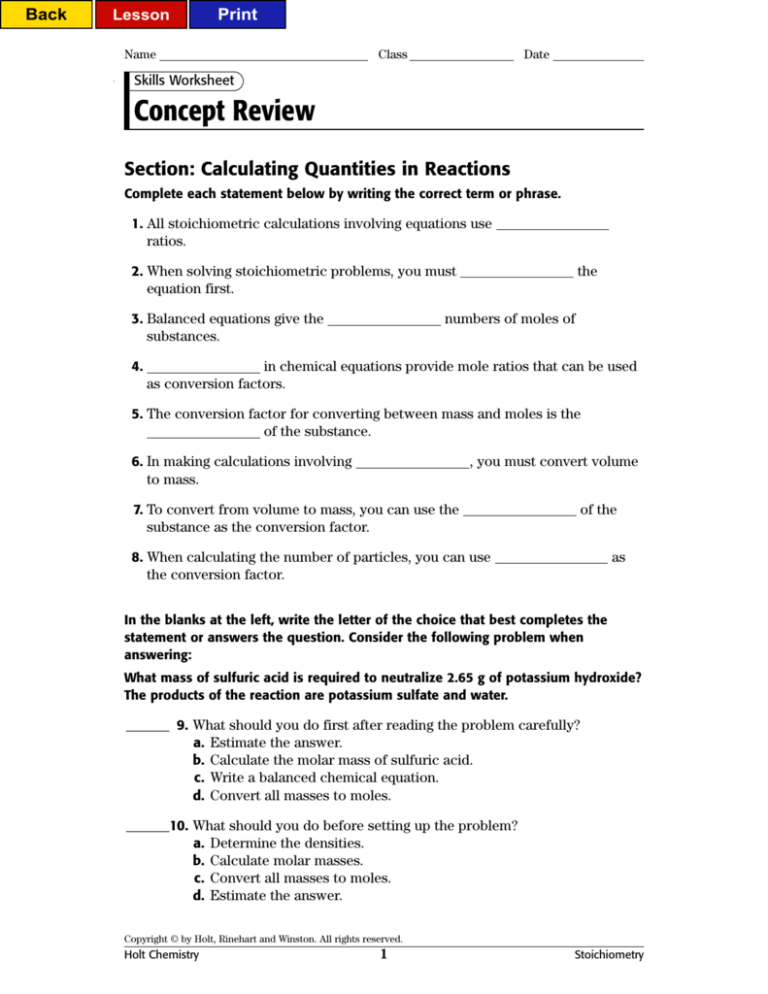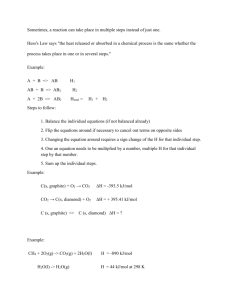
Back
Lesson
Print
Name
Class
Date
Skills Worksheet
Concept Review
Section: Calculating Quantities in Reactions
Complete each statement below by writing the correct term or phrase.
1. All stoichiometric calculations involving equations use
ratios.
2. When solving stoichiometric problems, you must
equation first.
3. Balanced equations give the
substances.
4.
the
numbers of moles of
in chemical equations provide mole ratios that can be used
as conversion factors.
5. The conversion factor for converting between mass and moles is the
of the substance.
6. In making calculations involving
to mass.
, you must convert volume
7. To convert from volume to mass, you can use the
substance as the conversion factor.
of the
8. When calculating the number of particles, you can use
the conversion factor.
as
In the blanks at the left, write the letter of the choice that best completes the
statement or answers the question. Consider the following problem when
answering:
What mass of sulfuric acid is required to neutralize 2.65 g of potassium hydroxide?
The products of the reaction are potassium sulfate and water.
______ 9. What should you do first after reading the problem carefully?
a. Estimate the answer.
b. Calculate the molar mass of sulfuric acid.
c. Write a balanced chemical equation.
d. Convert all masses to moles.
______10. What should you do before setting up the problem?
a. Determine the densities.
b. Calculate molar masses.
c. Convert all masses to moles.
d. Estimate the answer.
Copyright © by Holt, Rinehart and Winston. All rights reserved.
Holt Chemistry
1
Stoichiometry
Back
Print
Lesson
Name
Class
Date
Concept Review continued
______11. How should you check your setup?
a. by recalculating molar masses
b. by checking to see if the result will have the correct units
c. by estimating the answer
d. by writing a balanced chemical equation
______12. What should you round off?
a. the result of each step
b. all data values
c. only the final answer
d. nothing
______13. Which of the following is least likely to help you verify the final result?
a. estimating the answer by using rounded numbers
b. determining whether the answer is reasonable for the conditions of
the problem
c. rechecking all molar masses
d. writing a balanced chemical equation
Answer the following items in the space provided.
14. Determine the number of grams of phosphorus formed for each 1.00 g of
Ca3(PO4)2 used in the production of phosphorus in an electric furnace.
Ca3(PO4)2(s) 3SiO2(s) 5C(s) £ 3CaSiO3(s) 5CO(g) 2P(s)
15. How many grams of aluminum chloride are produced when 18 g of aluminum
are reacted with an excess of hydrochloric acid?
2Al(s) 6HCl(aq) £ 2AlCl3(aq) + 3H2(g)
Copyright © by Holt, Rinehart and Winston. All rights reserved.
Holt Chemistry
2
Stoichiometry
Back
Lesson
Print
Name
Class
Date
Concept Review continued
16. How many grams of ethanol, C2H5OH, can be made by the fermentation of
1150 g of glucose, C6H12O6?
C6H12O6(l) £ 2C2H5OH(l) 2CO2(g)
17. How many moles of oxygen are required for the combustion of 25.5 g of
magnesium?
2Mg(s) O2(g) £ 2MgO(s)
18. How many grams of CO2 are produced from the burning of 1.0 mol of amyl
alcohol?
2C5H11OH(l) 15O2(g) £ 10CO2(g) 12H2O(g)
19. How many moles of nitromethane are needed to form 500.0 g of chloropicrin,
CCl3NO2, a chemical used in the production of insecticides?
CH3NO2(l) 3Cl2(g) £ CCl3NO2(l) 3HCl(g)
Copyright © by Holt, Rinehart and Winston. All rights reserved.
Holt Chemistry
3
Stoichiometry
Back
Lesson
Print
Name
Class
Date
Concept Review continued
20. How many liters of oxygen are produced from the decomposition of 122 g of
potassium chlorate? The density of oxygen is 1.33 g/L.
2KClO3(s) £ 2KCl(s) 3O2(g)
21. How many grams of potassium chloride are formed by the decomposition of
sufficient potassium chlorate to yield 3.4 L of oxygen? Remember that the
density of oxygen is 1.33 g/L.
2KClO3(s) £ 2KCl(s) 3O2(g)
22. How many liters of phosphine gas are produced when 910 g of calcium
phosphide react with water? The density of phosphine gas is 1.517 g/L.
Ca3P2(s) 6H2O(l) £ 3Ca(OH)2(s) 2PH3(g)
23. How many grams of air are required to complete the combustion of 93 g of
phosphorus to diphosphorus pentoxide, assuming the air to be 23% oxygen by
mass?
4P(s) 5O2(g) £ 2P2O5(s)
Copyright © by Holt, Rinehart and Winston. All rights reserved.
Holt Chemistry
4
Stoichiometry
Back
Lesson
Print
Name
Class
Date
Concept Review continued
24. How many metric tons of carbon dioxide can be produced from the combustion of 5.00 metric tons of coke that is 85.5% carbon?
C(s) O2(g) £ CO2(g)
25. If 100. mL of carbon disulfide (density 1.26 g/mL) is burned completely, how
many liters of SO2 and of CO2 are formed?
CS2(l) 3O2(g) £ CO2(g) 2SO2(g)
Copyright © by Holt, Rinehart and Winston. All rights reserved.
Holt Chemistry
5
Stoichiometry
Back
Lesson
Print
TEACHER RESOURCE PAGE
Answer Key
22. 910 g Ca3P2 1 mol Ca3P2 /182.18 g
Concept Review:
Calculating Quantities in
Reactions
1.
2.
3.
4.
5.
6.
7.
8.
9.
10.
11.
12.
13.
14.
15.
16.
17.
18.
19.
20.
21.
Ca3P2 2 mol PH3 /1 mol Ca3P2 33.99 g PH3 /1 mol PH3 1 L
PH3 /1.517 g PH3 220 L PH3
23. 93 g P 1 mol P/30.97 g P 5 mol
O2 /4 mol P 32.00 g O2 /1 mol O2 100. g air/23 g O2 520 g air
24. 5.00 metric tons coke 85.5%
C/100.0% coke 1.00 106 g/1 metric
ton 44.01 g CO2 /1 mol CO2 1 mol
C/12.01 g C 1 mol CO2 /1 mol C 1 metric ton/1.00 106 g 15.7 metric
tons CO2
25. 100 mL CS2 1.26 g CS2 /1 mL CS2 1 mol CS2 /76.15 g CS2 2 mol SO2 /1
mol CS2 22.4 L SO2 /1 mol SO2 74.1 L SO2 74.01 L SO2 1 mol CO2 /2
mol SO2 37.1 L CO2
mole
balance
relative
coefficients
molar mass
liquids
density
Avogadro’s number
c
b
b
c
c
1.00 g Ca3(PO4)2 1 mol Ca3(PO4 )2 /310.18 g Ca3(PO4)2
2 mol P/1 mol Ca3(PO4)2
30.97 g P/1 mol P 0.200 g P
18 g Al 1 mol Al/26.98 g Al
2 mol AlCl3 /2 mol Al
133.33 g AlCl3 /1 mol AlCl3 89 g AlCl3
1150 g C6H12O6 1 mol
C6H12O6 /180.18 g C6H12O6
2 mol C2H5OH/1 mol C6H12O6
46.08 g C2H5OH/1 mol C2H5OH
588 g C2H5OH
25.5 g Mg 1 mol Mg/24.30 g Mg
1 mol O2 /2 mol Mg
0.525 mol O2
1.0 mol C5H11OH 10 mol CO2 /2 mol
C5H11OH 44.01 g CO2 /1 mol CO2
220 g CO2
500.0 g CCl3NO2 1 mol
CCl3NO2 /164.37 g CCl3NO2 1 mol
CH3NO2 /1 mol CCl3NO2 3.042 mol CH3NO2
122 g KClO3 1 mol KClO3 /122.55 g
KClO3 32.00 g O2 /1 mol O2 3 mol
O2 /2 mol KClO3 1 L O2 /1.33 g O2 35.9 L O2
3.4 L O2 1.33 g O2 /1 L O2 1 mol
O2 /32.00 g O2 2 mol KCl/3 mol O2 74.55 g KCl/1 mol KCl 7.0 g KCl
Concept Review: Limiting
Reactants and Percentage
Yield
1.
2.
3.
4.
5.
6.
7.
8.
9.
10.
11.
excess
limiting, product
limiting
stoichiometric
limiting
excess
percentage
actual; theoretical
actual
actual
3.00 g Mg (1 mol Mg/24.30 g Mg) 0.123 mol Mg
2.20 g O2 (1 mol O2/32.00 g O2) 0.688 mol O2
0.0688 mol O2 (2 mol Mg/1 mol O2)
0.138 mol Mg needed.
Mg is limiting.
0.123 mol Mg (2 mol MgO/2 mol Mg)
(40.30 g MgO/1 mol MgO) 4.96 g
MgO
Copyright © by Holt, Rinehart and Winston. All rights reserved.
Holt Chemistry
86
Stoichiometry








